GBPUSD is moving in an uptrend channel, and the market has reached a higher low area of the channel
Daily Forex Trade Setups July 22, 2025
Stay on top of market trends with our Daily Forex Trade Setups (July 22, 2025)
GBPUSD Flatlines as Market Eyes Washington’s Next Trade Move
When we talk about currency markets, we usually picture dramatic moves and flashy headlines. But sometimes, it’s the calm, sideways action that hides the most interesting stories. That’s exactly what’s going on with the British Pound (GBP) and the US Dollar (USD) right now. While it may look like “nothing is happening,” the truth is there’s a lot simmering beneath the surface—and it’s all tied to politics, policies, and some major decisions waiting to unfold.
Let’s break it down and explore what’s really keeping the Pound steady and what could shake things up soon.
The Bigger Picture: A Pause in the Pound’s Journey
The British Pound is currently moving sideways, showing very little change against the US Dollar. That doesn’t mean the market is quiet though. Instead, it signals that traders are holding their breath—waiting for bigger events to guide the next move.
While we often focus on central banks and interest rates, this time around, it’s trade deals and global politics taking center stage.
Global Trade Talk Drama: What’s Going On With the US?
One of the main reasons for this cautious market is the uncertainty swirling around the United States’ trade policy. The US government has been busy negotiating (and in some cases, not negotiating) trade deals with several countries.
Deals Done and Deals Delayed
So far, the US has signed trade agreements with the United Kingdom, Vietnam, and Indonesia. There’s also a limited agreement in place with China. But beyond that, a long list of countries—including Canada, Mexico, Japan, and the European Union (EU)—have been left in the dark. The US has already sent formal letters to 22 countries laying out its proposed tariff rates.
And it gets even more intense…
Trump’s Tariff Threats Resurface
US President Donald Trump is back in the spotlight, reportedly considering raising baseline tariffs even further—somewhere between 15% and 20%, up from an earlier 10% figure. This news has created waves, especially with the EU, which isn’t taking the threat lightly. European officials have made it clear: if Trump follows through, they will retaliate.
Now, imagine how all of this uncertainty affects traders and investors. If major global economies start slapping tariffs on each other, global trade slows down, costs rise, and currencies like the Pound and Dollar could swing wildly.
Why Investors Are Playing It Safe for Now
While the drama plays out, many investors prefer to stay on the sidelines. Here’s why.
Waiting for Data: The PMI Effect
This week, investors are closely watching upcoming data from both the UK and the US, especially the Purchasing Managers’ Index (PMI) reports. These reports show how well businesses are doing in both manufacturing and services sectors. A strong report can boost confidence in a country’s economy. A weak one? Not so much.
The UK’s PMI data is expected to show moderate growth, even though there are signs that companies have started cutting back on hiring. Why? Because labor costs are climbing, thanks to increases in employer contributions to social benefits and taxes.
This could be an early sign that economic momentum in the UK is slowing down, making traders cautious about betting heavily on the Pound right now.
BoE’s Interest Rate Decision Is Around the Corner
Another key piece of the puzzle is the upcoming Bank of England (BoE) policy meeting. Many experts believe the BoE will cut interest rates by 0.25%, which would bring them down to 4%. While such a move is mostly priced in by the market, investors still want to hear what BoE Governor Andrew Bailey has to say during his next testimony.
But here’s the twist—Bailey isn’t expected to give away much. So again, traders are holding off on making big moves until they know more.
The US Dollar’s Side of the Story
Meanwhile, on the other side of the Atlantic, the US Dollar is doing its own thing. After a brief dip, it’s now regaining strength. Why? Because investors are starting to think that the Federal Reserve (the US central bank) might not be in such a rush to cut interest rates after all.
Inflation Pressures Return
Recently released US inflation data showed that prices are creeping up again—especially on goods affected by those same sectoral tariffs we talked about earlier. This makes the Fed more cautious about cutting rates. The thinking goes: if inflation is still hanging around, why ease monetary policy?
As a result, the Dollar is holding firm, making it harder for the Pound to gain any ground.
GBPUSD is moving in an Ascending channel, and the market has fallen from the higher high area of the channel
What Could Change the Game Next?
We’re in a bit of a holding pattern right now, but that doesn’t mean it’ll last. There are a few key events coming up that could trigger big moves in the GBP/USD pair.
-
UK PMI Data (Coming Thursday): If this comes in much weaker than expected, it could raise fears of an economic slowdown, pressuring the Pound.
-
US PMI Data: Similarly, weak US data could pull the Dollar back down and give the Pound a bit of breathing room.
-
BoE Commentary: Even if Bailey doesn’t make big statements, any hint at future moves will be dissected by analysts.
-
US Tariff Announcements: If Trump officially announces higher tariffs, expect a sharp reaction—not just from currencies, but across global markets.
Final Thoughts: A Calm Market Doesn’t Mean a Quiet One
Right now, the Pound looks steady. But that calm is likely temporary. Big changes in trade policies, central bank actions, and economic data are all waiting just around the corner.
If you’re watching the GBP/USD pair, don’t let the sideways movement fool you. Behind the scenes, there are complex shifts happening that could lead to significant currency moves. For now, traders are cautious, but all it takes is one announcement or one unexpected data point to shake things up.
So stay tuned, because the stillness you see today might just be the silence before the storm.
EURUSD Gains Ground as ECB Lending Confidence Sparks Optimism
When you hear about the Euro holding steady or dipping slightly, it might sound like another ordinary market update. But behind those little movements lie stories of global power plays, policy shifts, and major economic expectations. So, if you’ve been wondering what’s been going on lately with the Euro and the US Dollar, buckle up—we’re breaking it all down in a super relatable way.
Let’s explore what’s influencing the Euro and US Dollar recently and why investors, traders, and even everyday folks are keeping an eye on their movement.
The Euro Holds Strong: What’s Keeping It Up?
Over the past couple of days, the Euro has managed to hold on to its gains—even after a small dip. That may not sound like a big deal, but in the world of currencies, even a tiny shift can mean a lot. So what’s helping the Euro stay strong?
EURUSD has broken the downtrend channel to the upside
Positive Vibes from the ECB Lending Survey
One of the biggest things supporting the Euro right now is a positive survey from the European Central Bank (ECB). It showed that banks across Europe didn’t really tighten their lending rules, which is great news. Even better? Demand for home and business loans went up in the second quarter. And that’s expected to continue into the coming months.
This kind of data gives investors confidence. When people and businesses are borrowing more, it usually signals that they feel good about the economy. And that kind of optimism can help keep a currency strong.
Confidence Boost from Financial Access
Just a day before the ECB survey dropped, there was another report about how companies in Europe are finding it easier to access financing. Think of it as getting approved for a loan more easily—whether to grow a business or invest in new opportunities.
When businesses have access to money, they tend to expand, hire more people, and boost economic growth. That adds more weight to the Euro’s positive tone and reassures investors that Europe is in decent shape, at least for now.
The US Dollar: Losing Its Shine Amid Growing Worries
While the Euro is getting a lift, the US Dollar isn’t having the best time. After a strong performance in recent weeks, the Greenback is starting to feel the heat. But why the sudden cool-down?
Tariff Tensions Are Back in Focus
The big cloud hanging over the US Dollar right now is the growing worry over tariffs. As the August 1 deadline for new tariffs approaches, the market is getting nervous. Investors hate uncertainty—and trade disputes are the very definition of that.
The tension between the US and European Union over trade is far from resolved. There’s talk of retaliatory moves from Europe, especially against services from the US. This has everyone on edge, and it’s starting to show in the way investors are reacting.
Fed Chairman Under Fire
Adding more fuel to the fire, US Federal Reserve Chair Jerome Powell has found himself under pressure from the White House. President Trump has publicly criticized him, even pushing for his resignation. That’s a big deal.
Central banks are supposed to be independent. When political pressure comes into play, it can mess with investor confidence. People start to wonder whether decisions are being made based on what’s best for the economy—or for politics.
While Powell is set to speak soon, he likely won’t talk much about interest rates because the Fed is in a quiet period before their next decision. Still, his comments could move the needle, especially if he addresses the pressure he’s been facing.
Traders Stay Cautious as EU-US Talks Drag On
Investors are usually a bit jumpy when there’s talk of tariffs or trade disagreements. And that’s exactly what’s happening with the EU and the US right now.
Hopes for a Deal Are Fading
Both sides have been trying to strike a trade agreement, but the tone is turning sour. Officials in Europe are starting to sound less optimistic. There’s chatter about the EU exploring “anti-coercion” measures if the US goes through with its unilateral trade actions.
Some countries are even preparing countermeasures that could hit US services—think tech firms, financial companies, and so on. That would escalate things even further and only add to the market jitters.
Risk Sentiment Is Weak
With all this uncertainty in the air, investors aren’t feeling super adventurous. When that happens, they tend to avoid riskier assets and stick to what feels safer—like cash or gold. This kind of risk-off mood is keeping major currencies from making big moves in either direction.
Even though the Euro is still showing strength, there’s definitely a ceiling on how far it can go until some of these bigger issues are cleared up.
What Else Are Markets Watching?
Apart from trade drama and political tension, markets are also tuned into the earnings season. Big tech companies like Alphabet (Google’s parent) and Tesla are releasing their quarterly results soon, and that could influence how people feel about investing in general.
Over in Europe, SAP (the software giant) is also under the microscope. Investors want to see whether a stronger Euro is hurting revenue for companies that sell a lot outside the region. These results could give some insight into how well European businesses are handling currency shifts.
The Takeaway: Why This All Matters to You
Whether you’re an investor, a business owner, or just someone curious about how the world economy works, these updates on the Euro and US Dollar tell a bigger story.
Here’s what to keep in mind:
-
The Euro is showing resilience, helped by positive financial data and decent borrowing demand across Europe.
-
The US Dollar is under pressure, thanks to trade uncertainty and political tension around the Fed.
-
Markets are in wait-and-see mode, as traders look for clarity on trade deals and earnings from major companies.
These aren’t just currency headlines—they’re snapshots of global trends and economic health. And while the jargon can be confusing, the core idea is simple: stability, trust, and clear direction matter. And right now, there’s not a lot of that going around.
So, keep an eye on the news, stay informed, and if you’re in the world of trading or investing, remember that caution might just be your best friend in times like these.
USDJPY Climbs Higher as Trade Negotiations Take Center Stage
When it comes to currency movements, it’s not just numbers and charts that matter. What really drives currencies like the US Dollar and Japanese Yen are the political and economic stories unfolding in the background. And right now, there’s a lot going on between the US and Japan that’s stirring up the market.
Let’s break it down and explore what’s causing the recent shifts in the USD/JPY exchange rate, especially with all eyes on trade talks and leadership moves in both countries.
The Election Aftermath in Japan: A Surprise, But Not a Shock
Japan recently held elections, and while the ruling coalition didn’t come out on top, it didn’t rattle the market as much as some expected. The Japanese Yen actually strengthened right after the results came in, mainly because investors were bracing for worse news.
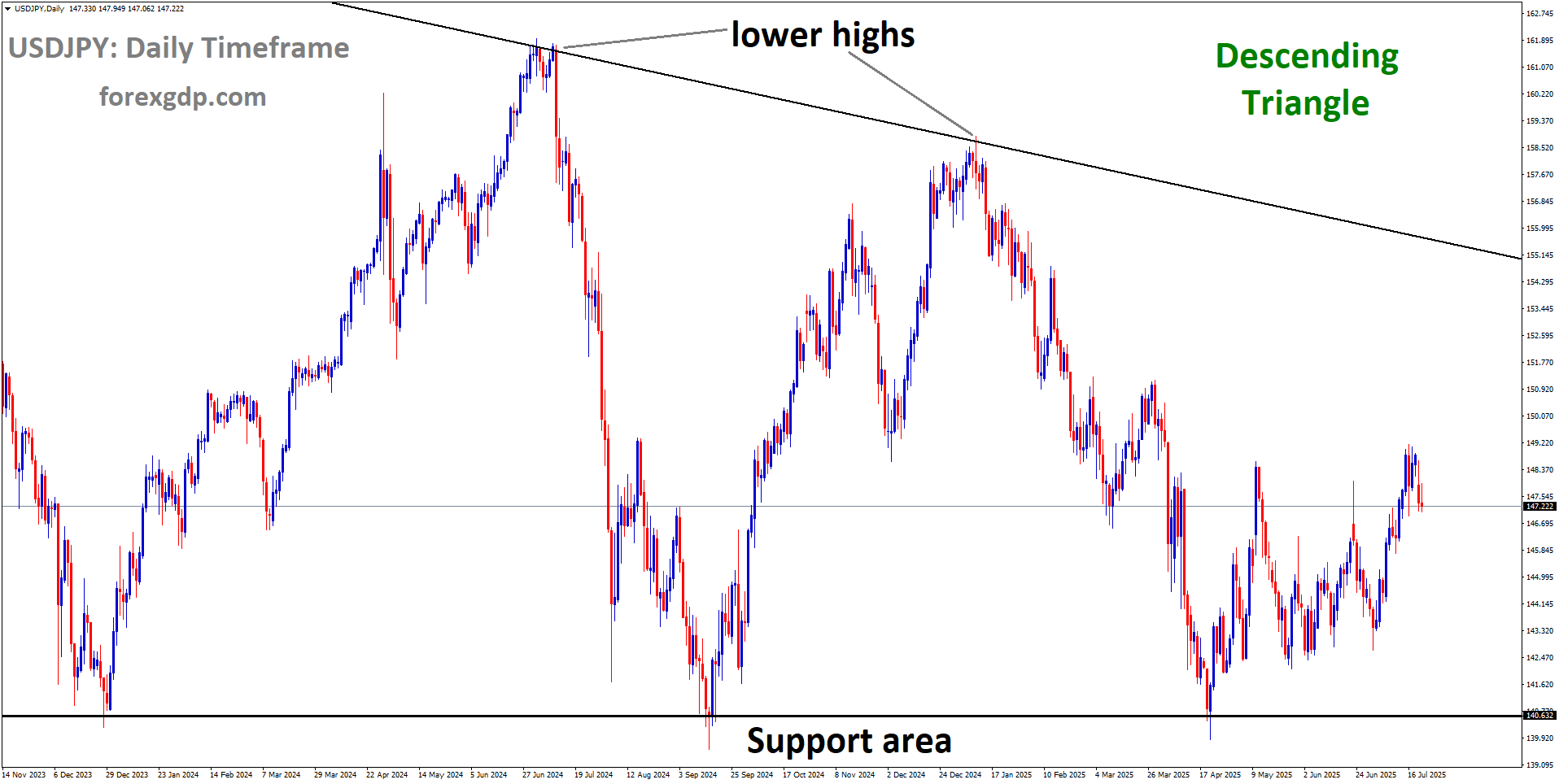
USDJPY is moving in a descending triangle pattern
Why did the Yen initially react well?
Because Prime Minister Isiba made it clear that he wasn’t going anywhere. Despite the political shake-up, he vowed to stay in power. For global investors, this was a big sigh of relief. Why? Because continuity means predictability—and in the world of currency trading, that’s a huge deal.
There was also another hidden reason for the relief. The main opposition party had plans for massive tax cuts. While that might sound good on paper, for many investors, that’s a red flag. Slashing taxes can lead to budget deficits and economic instability—two things that tend to weaken a country’s currency.
So even though the election results showed some dissatisfaction, the market found comfort in the fact that there wouldn’t be any radical policy changes just yet.
Trade Talks: All Eyes on the US-Japan Standoff
After digesting the election drama, traders quickly turned their attention back to something even more uncertain: US-Japan trade negotiations.
There’s been growing tension between the two countries, especially as the deadline for a potential trade deal looms. August 1st is the magic date, and the closer we get to it without a deal, the more nervous the market becomes.
What’s the problem?
President Trump hasn’t been shy about criticizing Japan for what he sees as an unfair trade balance. He’s particularly frustrated with how few American cars and agricultural products—like rice—make it into Japan. Meanwhile, Japanese exports to the US keep rolling in.
This uneven trade flow has been a thorn in Washington’s side for a while, and the threat of imposing 25% tariffs on Japanese goods has been floating in the air like a storm cloud.
What’s Japan doing about it?
In response, Japan sent its top negotiator, Rosei Akazawa, to Washington in hopes of smoothing things over. But so far, progress has been slow. While there’s a willingness to talk, the actual terms of a deal remain fuzzy.
For now, it looks like both sides are still stuck in a standoff, which isn’t doing the Yen any favors. Every bit of uncertainty makes investors cautious—and they tend to favor the Dollar in times like these.

US Comments Adding Fuel to the Fire
On the American side, Treasury Secretary Bessent recently made headlines with his comments about the trade talks. He emphasized that the US isn’t just rushing to sign any deal—they want a quality agreement, one that truly benefits American businesses and workers.
That might sound reasonable, but it also signals that a quick resolution is unlikely. The focus on “quality over timing” suggests the negotiations could stretch on, keeping everyone guessing and keeping the market on edge.
The Dollar, in this case, is gaining ground not necessarily because of confidence—but because it’s the default safe zone when things look shaky elsewhere.
Fed Chairman Powell’s Speech: A Potential Game-Changer
Another major event that traders are keeping an eye on is a speech from Federal Reserve Chair Jerome Powell. Although he’s not expected to discuss interest rates directly (thanks to a pre-meeting quiet period), his remarks could still move markets.
Why?
Because there’s a growing conversation about how independent the US central bank really is. President Trump has been openly critical of the Fed, and any hint from Powell about maintaining independence—or caving to political pressure—could ripple through global markets.
Even if Powell avoids controversy, just his tone and the issues he chooses to highlight can offer insight into how the Fed is thinking. And that, in turn, influences where the Dollar heads next.
So What Does This Mean for You and Me?
If you’re involved in international business, forex trading, or even just planning a trip to Japan, these developments matter. The tug-of-war between the Dollar and Yen isn’t just a financial story—it’s a political and diplomatic one.
The stronger Dollar right now reflects a mix of concern over Japanese political direction, frustration in the trade arena, and uncertainty around how the US will move forward. Until those pieces become clearer, we can expect more back-and-forth between the two currencies.
Here’s What to Watch Moving Forward
-
Trade Talk Updates: Any positive headlines from Washington or Tokyo about progress in negotiations could cause sudden moves in the Yen’s favor.
-
Political Developments in Japan: Will Prime Minister Isiba be able to hold onto power and keep pushing for a deal?
-
US Policy Remarks: Pay attention to official comments from Powell, Bessent, or the White House. Their tone matters more than the actual words.
-
Market Sentiment: Even if there’s no real news, market reactions can shift based on investor mood. And right now, that mood is cautious.
Final Summary
The Dollar’s recent climb against the Yen isn’t just about economics—it’s about uncertainty, diplomacy, and investor psychology. With trade talks hitting roadblocks and leadership questions swirling in Japan, investors are hedging their bets by sticking with the Dollar.
As we move closer to that crucial August deadline, the back-and-forth is far from over. Keep your ears open and your eyes on the headlines—because when it comes to currencies, the real story is often what’s happening behind closed doors.
USDCHF Wavers While Markets Brace for Trade Negotiation Fallout
The USD/CHF currency pair has recently shown a minor drop, slipping during Tuesday’s Asian session. While the movement might seem subtle on the surface, there’s actually a lot happening behind the scenes. This isn’t just a random market fluctuation—it’s closely tied to broader concerns like trade negotiations, central bank independence, and U.S. economic policy developments.
USDCHF is moving in an Ascending channel, and the market has reached a higher low area of the channel
Let’s break it all down so you know what’s really influencing this currency pair right now—and what might come next.
The Big Story: Trade Deadlines and Global Tension
One of the key reasons for the dip in USD/CHF is tied to a major trade deadline. The U.S. government, under President Trump’s administration, set an August 1 deadline for various countries to strike trade deals with the U.S. If they don’t, new tariffs could come into play.
This looming deadline has put a lot of pressure on financial markets. Uncertainty is never a good friend to investors, and this kind of scenario creates a nervous environment. When investors aren’t sure what’s going to happen next—especially when tariffs are involved—they often move their money to safer places.
That’s where the Swiss Franc comes in.
The Swiss Franc (CHF) is known as a “safe-haven” currency. That means when times get tough or unpredictable, investors like to park their money there. It’s seen as more stable and secure, especially compared to the U.S. Dollar during times of political or economic turbulence.
So, as fears rise around the upcoming trade talks, many investors are shifting their attention to the Swiss Franc, pulling value away from the USD/CHF pair.
Leadership Shake-Ups and Central Bank Concerns
There’s another layer to this story that’s worth paying attention to: the growing tension over central bank independence in the United States.
Recently, rumors started swirling that President Trump might fire the current Federal Reserve Chairman, Jerome Powell. Even though Trump denied the reports in a public post, the speculation alone was enough to rattle markets.
Why does this matter?
Because the independence of a country’s central bank is a cornerstone of its economic credibility. If a president is seen as interfering too much with monetary policy, it can shake investor confidence in the U.S. Dollar.
That’s exactly what’s happening here. Even the mere idea that the Fed could be under political pressure is enough to make investors wary of holding the dollar. This lack of confidence, again, leads to more buying of the Swiss Franc, pushing the USD/CHF lower.
U.S. Treasury’s Warning Signals
Adding more fuel to the fire, U.S. Treasury Secretary Scott Bessent raised serious concerns about the Federal Reserve’s expanding role. According to Bessent, the central bank’s focus has drifted from core monetary policy into broader areas it wasn’t designed to handle. He referred to this as “mandate creep,” and said it’s a danger to the Fed’s independence.
He also pointed out that the current financial regulatory system in the U.S. is outdated and needs significant reform. One major criticism he had was the so-called “dual capital requirements” for banks—a rule he called flawed and in need of rethinking.
This kind of public criticism from a high-ranking official puts even more pressure on financial markets. When internal government disagreements over how to handle economic policy spill out into the open, investors start to question whether the system is working smoothly.
And when confidence dips, so does the value of the U.S. Dollar.
Why This Matters for You
If you’re someone who trades forex or just keeps an eye on global economic trends, all of this is more than just headlines. It’s a real shift in how investors are viewing the U.S. economy, and it has ripple effects across multiple markets.
Here’s what you should keep in mind:
-
Trade Uncertainty = Swiss Franc Strength: Whenever there’s global trade drama, especially involving the U.S., the Swiss Franc often gains value as investors look for safety.
-
U.S. Political Pressure = Dollar Weakness: Any time there are reports of political meddling in central bank affairs, the dollar tends to take a hit. Markets value independence and transparency—and they react fast when those principles are questioned.
-
Regulatory Reform Talks = Market Jitters: Discussions about overhauling financial systems or shaking up long-standing regulations usually lead to short-term market hesitation. Traders and investors don’t like surprises.
A Quick Look Ahead
With the August 1 trade deadline fast approaching, expect market volatility to stay high. Every statement from government officials, every trade negotiation update, and every social media post by prominent leaders will be under a microscope.
If countries manage to strike last-minute deals with the U.S., we might see some rebound in the dollar. But if talks fail and tariffs go into effect, safe-haven currencies like the Swiss Franc could strengthen even more.
Also, keep an eye on the Fed. Even if Jerome Powell keeps his job, any sign that the central bank is bending to political pressure could lead to further weakening of the dollar.
Final Thoughts
Right now, the USD/CHF currency pair is caught in a web of trade tension, political drama, and policy debates. These aren’t just technical market blips—they’re big, interconnected themes that reflect deeper shifts in global confidence.
Whether you’re an active forex trader or just someone trying to stay informed, it’s worth watching how these stories develop. The outcomes will likely shape the path of the dollar, the Swiss Franc, and broader financial markets in the weeks to come.
NZDUSD Drops as Cooling Inflation Fuels RBNZ Rate Cut Speculation
The NZD/USD currency pair has recently dipped a bit lower, hovering close to the 0.5960 mark during early Tuesday trading in Asia. Now, before we dive into the details, let’s take a moment to understand what’s behind this move. The key driver? New Zealand’s inflation data just came in, and it’s a little softer than expected. That’s sparking fresh talks about the Reserve Bank of New Zealand (RBNZ) possibly cutting interest rates soon.
Let’s break this down in simple terms. Inflation is basically the rate at which prices go up. Central banks, like the RBNZ, try to keep inflation in check by adjusting interest rates. So, when inflation slows down, it gives them room to cut rates to support the economy. And that’s exactly what markets are thinking might happen in New Zealand.
Cooling Inflation in New Zealand: What Does It Mean?
Fresh CPI Numbers Just Dropped
The latest inflation data from Statistics New Zealand has caught everyone’s attention. The Consumer Price Index (CPI)—which measures how much prices are rising—grew by 2.7% over the past year. That might sound like a lot, but here’s the kicker: analysts were expecting it to go up by 2.8%, so it’s actually a little weaker than forecast.
On a quarterly basis, inflation rose just 0.5% between April and June. That’s down from 0.9% in the previous quarter and again, below expectations. So what we’re seeing here is a clear signal that inflation is starting to cool down.
RBNZ Rate Cut Speculation Heats Up
Because of this soft inflation reading, financial markets are now betting that the RBNZ might go ahead and reduce its official cash rate as early as August. In fact, the odds are pretty high—around 85%—that we’ll see a 0.25% cut at that meeting.
NZDUSD is moving in an Ascending channel
Why is this such a big deal? When interest rates drop, a currency typically weakens. That’s because lower rates mean lower returns for investors. So with a potential rate cut on the table, the New Zealand Dollar is feeling some pressure against the US Dollar.
How the U.S. Factor Is Balancing the Equation
Fed Drama Grabs Headlines
While the New Zealand side of the equation is pulling the NZD/USD lower, there’s something happening in the U.S. that’s providing a bit of balance. Over the weekend, there were some political rumblings involving the U.S. Federal Reserve.

A report suggested that Treasury Secretary Scott Bessent had convinced President Donald Trump not to fire Fed Chair Jerome Powell. The White House responded by saying that the President isn’t planning to remove Powell. Still, even the mention of it stirred concerns about the Fed’s independence.
Why does this matter? The Federal Reserve is supposed to make its decisions based on economic data—not political pressure. Any signs that the Fed could be influenced by politics tend to make investors a little uneasy. And that uncertainty can sometimes lead to mixed reactions in the currency markets.
So while the New Zealand Dollar is facing downward pressure due to domestic inflation and rate cut expectations, worries about the U.S. Federal Reserve are limiting how far the NZD/USD pair can actually fall.
Bigger Picture: What This Means for You and the Market
Let’s say you’re someone who follows currency pairs for trading or business. Here’s what all of this could mean in practical terms:
-
Lower NZD Ahead? If the RBNZ does cut rates in August, we could see more softness in the New Zealand Dollar. That might create opportunities for traders looking to go short on the NZD or long on the USD.
-
Watch the Fed Headlines: With U.S. politics entering the picture, it’s important to keep an eye on what’s coming out of Washington. Anything that affects the Fed’s credibility could shake up the markets fast.
-
Inflation Matters Big Time: This whole situation underscores just how much influence inflation reports have on currencies. Even a small deviation from expectations—like we saw with New Zealand’s CPI—can move the market in a big way.
Final Summary
To sum it all up, the NZD/USD pair is feeling some heat this week. Softer inflation in New Zealand is raising expectations of a rate cut by the Reserve Bank of New Zealand, and that’s putting pressure on the Kiwi dollar. At the same time, uncertainty around the U.S. Federal Reserve’s independence is keeping the pair from falling too sharply.
If you’re watching this currency pair closely—whether for trading, business, or just out of curiosity—now’s a good time to stay alert. Between central bank decisions and political developments, things could shift quickly. Keep an eye on the news and be ready to adapt. The story of NZD/USD is still unfolding, and the next chapter could come sooner than you think.
Don’t trade all the time, trade forex only at the confirmed trade setups
Get more confirmed trade signals at premium or supreme – Click here to get more signals, 2200%, 800% growth in Real Live USD trading account of our users – click here to see , or If you want to get FREE Trial signals, You can Join FREE Signals Now!

